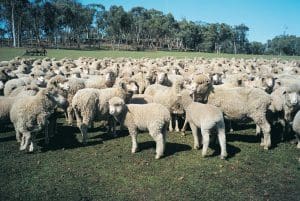
A new WA report will outline the lamb price incentives needed to produce out-of- season lambs to target new markets.
PRICES for out-of-season lambs would need to increase significantly in Western Australia to lift production, a recent economic analysis has shown.
A new WA report will outline the lamb price incentives needed to produce out-of-season lambs to target new markets.
The analysis prepared for the WA Department of Agriculture and Food department’s Sheep Industry Business Innovation project concluded that a price increase of 30-40 cents per kilogram dressed or carcase weight was required for producers to break-even when turning off lambs one month later.
The project supports the sheep industry’s goal to grow supplies to secure new market opportunities and the economic analysis will be outlined at the department’s Agribusiness Sheep Updates on August 30.
Consultant John Young was commissioned by the department to investigate what price is required to provide an incentive for growers to produce out of season lambs.
Mr Young said Western Australian lamb supplies currently peak during spring, reflecting the low cost of finishing stock on green feed, then tail off as the season progresses and production becomes more expensive.
“To secure new markets, processors require a consistent supply through the season,” he said.
“While higher prices are offered by processors for out of season lambs, historically these premiums have not been sufficient to entice a significant number of producers to change their production systems to turn off lambs later in the season.”
The analysis concluded that a price increase of 30-40 cents per kilogram dressed or carcase weight was required for producers to break-even when turning off lambs one month later.
“In the Great Southern, for example, the price of lamb in May-June would need to be between $6.25-6.55/kg cwt to entice growers to produce carry-over lambs instead of sucker lambs in Nov-Dec at a price of $4.50-5.00/kg cwt,” Mr Young said.
“In the central Wheatbelt the breakeven price is slightly greater at $6.10-7.10.
“Both of these examples are higher than the five year average increase of $0.16/month observed during the period 2010-15,” he said.
The report also noted the risks associated with producing out-of-season lambs and the market exposure to fluctuations in grain prices. It also addressed the issue of increased carcase weights, as a result of carry-over lamb compared with sucker lambs.
“The solution may be for processors to create a stronger forward pricing mechanism to attract more growers into producing out-of-season lambs to increase the total lamb supply,” Mr Young said.
The department is sharing the report with growers and the processing sector to investigate a suitable business model to grow WA lamb production and capture new market opportunities.
Department senior development officer Mandy Curnow said the ‘Price Signals Required to Alter the Seasonal Turn-off of Lamb’ report provided a valuable insight into the WA sheep industry and what was required for it to continue to grow.
“There is growing global demand for sheepmeat, which the WA industry is in a good position to satisfy if it can build supply,” Ms Curnow said.
“The department will use this report to discuss opportunities with processors and the potential for some producers to target the carry-over market or develop feedlot businesses to meet the demand in the out-of-season times.”
Mr Young will discuss his report at Sheep Updates, Tuesday, 30 August at the UWA Club in Perth.
The theme of this year’s updates is ‘Sharpening the sheep business’ and will explore future opportunities for the WA sheep industry. For further information or to register visit agric.wa.gov.au and search for ‘sheep updates’. Sheep Updates is delivered by the department’s Sheep Industry Business Innovation project, made possible by State Government Royalties for Regions investment.
Source: DAFWA.

HAVE YOUR SAY